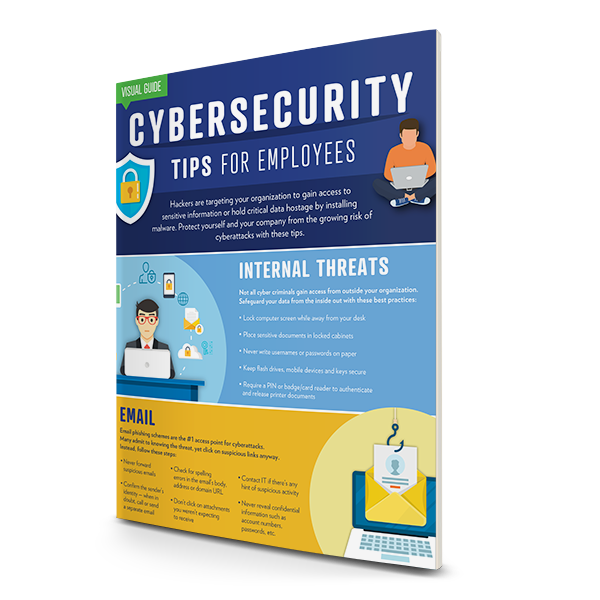Mobile devices allow today’s workforce to optimize productivity when working remotely. While increased connectivity can be a good thing, it could also leave a door open for hackers to enter a business’ network and gain control of their data.
In fact, the Ponemon Institute conducted a study showing that lost or stolen devices caused an average organizational loss of $3.44 million/annually.
This is why it’s critical for businesses to have a Mobile Device Management (MDM) solution. An MDM is a platform designed for smartphones and tablets that provides software distribution, policy management, inventory management, security management and service management.
As the remote workforce has grown, so has the need for MDM platforms. In fact, the global MDM market is projected to more than quadruple in size from 2022 to 2029.
When evaluating MDM solutions, here are five considerations to keep in mind.
- Security
- Supported Devices
- Scalability
- Onsite vs. Cloud Hosting
- Ease of Implementation
1. Security
Many business have implemented a bring your own device policy (BYOD), especially for mobile device use. While this has helped to increase employee productivity, without an MDM solution in place, businesses could be left vulnerable to hackers in the event that a mobile device is lost or stolen.
Often, we’ve seen smaller and mid-market businesses viewing BYOD policies as a lower security risk than it often is. If your company has a BYOD policy, you need an MDM.
The top three things you’ll need to secure a mobile device are a device passcode lock, data encryption and the ability to remotely remove corporate data or wipe the memory of the device.
An excellent MDM solution includes these controls to better secure devices. In addition, the business could be able to publish their own “app store,” for employees to have quick, downloadable access to the apps they’ll need.
In general, an MDM solution is a really good way to set up controls for device access, authorization and encryption for the applications that the organization uses.
We’ve also seen MDM not only used for security, but also to meet industry compliance standards for Department of Defense or HIPAA-regulated environments.
FURTHER READING: How Often Should You Do Cybersecurity Awareness Training?
2. Supported Devices
When considering MDM options, look for a solution that will meet the diverse device needs of your employees. Your MDM solution should be compatible with Apple and Android phones.
3. Scalability
There’s a multitude of MDM solutions for you to evaluate. However, many businesses have shifted to using the cloud for collaboration, email, document storage and more.
That’s why Elevity has found that the Microsoft Office 365 stack is commonly used in many of today’s work environments, including on remote devices. Therefore, if a business is already invested in Microsoft® products, Microsoft Intune (MDM software solution) is a natural extension of the stack allowing administrators to control the entire stack for smartphones, tablets, Windows desktops, etc. via a single dashboard.
This extension of a software stack that you may already have, will also allow for a faster, smoother MDM solution rollout and encourages simple scalability to change along with the growing needs of your business.
We’ve found that Microsoft’s Intune platform has a high ability to execute along with a completeness of vision for the product – head and shoulders above the competition.
Most people nowadays, if they are searching for an MDM solution – it just makes sense to go with Intune. Saves time, saves space and saves financial resources versus the competition.
4. Onsite vs. Cloud Hosting
How your MDM platform will be hosted, is another consideration to keep in mind. There are two options: onsite with physical servers at your company’s location or hosted in the cloud.
Onsite physical servers are the more traditional method to manage endpoints, however fewer companies are choosing this route than in years past. Physical servers require a large, upfront cost to purchase, a dedicated server room, resources to maintain the security of the servers and a conduit between the servers and the end user devices for them to communicate with each other. Set-up can often be complex and tie up your IT team’s resources, as well.
Cloud hosted servers, charge comprehensive monthly fees. This may look like a lot of money, especially to small or medium-sized businesses. However, if you compare the total cost of ownership between onsite and cloud-based hosting, cloud-based hosting is less expensive. When accessing a cloud-based host, there are less risks, faster installation, less maintenance, no dedicated server space needed physically at your company and a predictable, monthly cost for your budget.
In fact, if you already have Microsoft Office 365 licensing, adding the Intune MDM solution is typically only a small monthly cost increase compared to what you’re currently paying.
I’d also like to point out that some organizations with Microsoft Office 365 packages may already have Intune included in the price – why not use it? A cloud-based MDM solution is quick to set up and all of the costs are built into the monthly fee
5. Ease of Implementation
A comprehensive communication plan is key to successfully implement your MDM platform. Companies with a BYOD policy commonly find a small percentage of their employees to have concerns about installing an MDM on their personal device.
I recommend that you start your communication plan for MDM implementation, early. Because transparency with your employees is important and you should overcommunicate what an MDM is and exactly how your company will use it. Your employees will appreciate the transparency and respect you for answering their questions.
In the event that an employee is hesitant to comply with the request to install the chosen MDM platform onto their personal device, the organization needs to have a backup plan. Alternate possibilities include offering the employee a corporate device for company use or sometimes companies have offered their employees financial incentives to help defray the cost of the mobile device and monthly user fees.
Be sure to include in your communication plan:
- That a password/pin code will be required to protect the device
- What the rules are for the complexity of the password
- That the device will be encrypted
- Corporate will have access to wipe out data, but only through the corporately controlled apps
Starting with a good communication plan will ensure a smooth implementation for your MDM platform.
Elevity and Mobile Device Management Solutions
Take the guesswork out of selecting and implementing an MDM solution at your business. Contact Elevity to learn more about how our own 4S approach can protect your technology and assets through Strategy, Security, Solutions and Support.
Want to learn more about how to protect yourself and your company form the growing risk of cyberattacks? Click the link below to download our free Cybersecurity Tips for Employees.





%20cropped.jpg)




